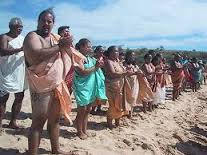 David Kalama
David Kalama The film opens with the gut-wrenching footage of massive explosions raising incongruous plumes, framed by an outline of the island. This is a glimpse of the painful awakening that must have been experienced by George Helm, Kimo Mitchell, Walter Ritte, Emmett Aluli and the many others who contributed to the rebirth of the island. For the early Hawaiians, Kaho`olawe was a spiritual home with many sacred sites as well as a navigational training center that embodied all aspects of the Hawaiian culture. In fact its ancient name, Kohe Mālamalama O Kanaloa, means a place of shining light to the wisdom of the Hawaiian ocean god of navigation and currents, Kanaloa. It is a source of Hawaiian Culture, for without the guidance of Kanaloa, how would the Polynesians have discovered Hawai`i and thrived here?

While chronicling the struggle to reclaim the island, the film also highlights the equally important healing process. Between the 1980 consent decree with the U.S. government that restricted military use to one third of the island and 1990, the last of any military use of the island, PKO members were allowed monthly “access” (the term given to civilian visitation) to Kaho`olawe. A permanent base camp was established, plant life restored and erosion control put in place. Makahiki celebrations and other traditional practices, under the guidance of the Edith Kanaka`ole Foundation, began the spiritual healing to restore Kohe Mālamalama O Kanaloa to a state of sacredness.
 Maxine Kahaulelio
Maxine Kahaulelio The film Kaho`olawe captures the contributions of the many hands and hearts that have contributed to the healing and reincarnation of this cultural center of the Hawaiian Nation and raises awareness of the deep spiritual nature of Hawai`i. This was made possible by Kūkulu Ola, a timely film series that seeks to raise community awareness and provides a unique community forum. The last film of this year, Skin Stories by Lisa Altieri and Emiko Omori, will be shown on December 17th at 6:30.
*Named Ghost Bay by fisherman because of its changeable conditions.
 RSS Feed
RSS Feed
